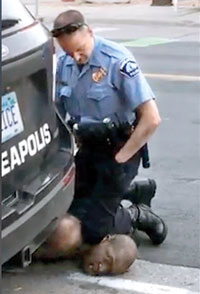Sunday Times 2
I can’t breathe: The two autopsies

A still from the viral video clip that showed office Chauvin pressing his knee on the neck of George Floyd
It all began at 20:01 on the evening of May 25, when a store employee from “Cup Foods”, a grocery store, reported to the police by calling 911, that a man bought a pack of cigarettes and gave a fake $20 bill.
At around 20:08, two police officers arrived and the store employee pointed to the man’s parked car around the corner.
The 46-year-old George Floyd was sitting with two other people in the car. After approaching the car, one of the officers, Thomas Lane, pulled out his gun and ordered Floyd to show his hands. Why Lane thought it necessary to draw his gun is not explained.
Lane put his hands on Floyd, and pulled him out of the car. Then Floyd actively resisted being handcuffed.
Once handcuffed, Floyd became compliant while Lane explained he was being arrested for “passing counterfeit currency”.
It was when officers tried to put Floyd in their squad car that a struggle ensued. At around 20:14, Floyd “stiffened up, fell to the ground, and told the officers he was claustrophobic,” according to the Police report.
Officer Derek Chauvin and other officers were involved in further attempt to put Floyd in the police car. During this attempt, at 20:19, Chauvin pulled Floyd out of the passenger side, causing him to fall to the ground. He lay there; face down, still in handcuffs.
That was when witnesses started to film Floyd, who appeared to be in a distressed state. These moments, captured on multiple mobile phones and shared widely on social media, would prove to be Floyd’s last.
Officer Alexander Kueng held his back while Lane held his legs and none of the officers altered their position. The officers had an exchange: “You are talking fine,” one said to Floyd. Lane asked Chauvin, “Should we roll him on his side?” Chauvin replied, “No, staying put where we got him.”
Floyd was restrained by officers, while Chauvin placed his left knee between Floyd’s head and neck. “I can’t breathe,” Floyd said repeatedly. “I can’t breathe; mama; please, please, please!”
For eight minutes and 46 seconds, Chauvin kept his knee on Floyd’s neck.
Lane expressed that he was worried about excited delirium or another effect this position could do to Floyd. Chauvin said, “That’s why we have him on his stomach.” Two minutes before the video ended, Floyd stopped moving.
About six minutes into that period, Floyd became non-responsive. In videos of the incident, this was when Floyd fell silent, as bystanders urged the officers to check his pulse.
Kueng did just that, checking Floyd’s right wrist for pulse, but couldn’t find one. Yet, the officers did not move.
At 20:27, Chauvin removed his knee from Floyd’s neck. An ambulance arrived and motionless Floyd was rolled on to a wheeled stretcher and taken to the Hennepin County Medical Centre. He was pronounced dead around an hour later.
Charges were elevated from third to second-degree murder for Chauvin who was fired, arrested and charged. “Perpetrating eminently dangerous act and evincing depraved mind”, reads the complaint. Nine days after Floyd’s death other three police officers involved have also been charged for aiding and abetting murder.
The post-mortem nasal swab of Floyd was found to be positive for coronavirus. Chief Medical Examiner Dr. Andrew Baker said “the autopsy result most likely reflects asymptomatic but persistent PCR positivity from previous infection”, meaning the virus played no known role in Floyd’s death.
The whole world witnessed the death of George Floyd on Monday when a viral video showed a Minneapolis police officer kneeling on Floyd’s neck for almost 9 minutes. Minnesota governor said on Floyd’s death: “Thank God a young person had a camera to video it.”
“Essentially, George died because he needed a breath,” Benjamin Crump, an attorney for the family, said at a news conference on Monday.
The Hennepin County Medical Examiner (ME) conducted the autopsy saying that asphyxia was not the cause of death! Floyd had underlying health issues including hypertensive heart disease and coronary artery disease. Both diseases combined with being restrained by the police, plus any potential intoxicants may have contributed to his death. The full ME’s report is still pending.
However, George Floyd’s family has retained a prominent forensic pathologist, 85-year-old Dr. Michael Baden, a former New York City Chief Medical Examiner to perform an independent autopsy.
The official results contrast with an independent autopsy performed by Dr. Baden and the University of Michigan’s Allecia Wilson. They determined that Floyd died of “Asphyxiation from sustained pressure after being pinned down by his neck and back.” Dr. Baden said no underlying medical conditions caused or contributed the Floyd’s death.
The two autopsies of George Floyd differ on exactly what caused his death, but they agree on this much: George Floyd was a victim of homicide.
What else it could be?
(ravindrafernando@hotmail.co.uk)


